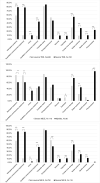The epidemiology, clinical presentation, and predictors of severe Tick-borne encephalitis in Lithuania, a highly endemic country: A retrospective study of 1040 patients
- PMID: 33211708
- PMCID: PMC7676731
- DOI: 10.1371/journal.pone.0241587
The epidemiology, clinical presentation, and predictors of severe Tick-borne encephalitis in Lithuania, a highly endemic country: A retrospective study of 1040 patients
Abstract
Introduction: In recent decades, the incidence of Tick-borne encephalitis (TBE) has been increasing and posing a growing health problem because of the high costs to the healthcare system and society. The clinical manifestations are well studied but there is a lack of research analyzing the severity of the disease.
Objective: The aim of this study was to analyze the epidemiology and clinical presentation of severe TBE, to identify the predictors for a severe disease course, and also predictors for meningoencephalomyelitic and severe meningoencephalitic/encephalitic forms.
Methods: A retrospective study was conducted in the Center of Infectious Diseases and the Center of Neurology at Vilnius University Hospital Santaros Klinikos in the years 2005-2017 to describe the clinical and epidemiological features of TBE in adults.
Results: 1040 patients were included in the study. A total of 152/1040 (14.6%) patients had a severe course. The highest proportion of severe cases, reaching 41.2%, was reported in the 70-79 year-old age group. A total of 36/152 (23.7%) severe patients presented meningoencephalomyelitis. Myelitic patients were older, were frequently infected in their living areas, and usually reported a monophasic disease course compared with severe meningoencephalitic/encephalitic patients. Severe meningoencephalitic/encephalitic patients, compared with non-severe meningoencephalitic/encephalitic, were older, less often noticed the tick bite, and often had a monophasic course. The sequelae on discharge were observed in 810/1000 (81%) of patients.
Conclusions: The prognostic factors associated with a severe disease course and severe meningoencephalitic form are: older age, comorbidities, a monophasic course, a fever of 40˚C and above, CRP more than 30 mg/l, CSF protein more than 1 g/l, delayed immune response of TBEV IgG, pathological findings in CT. Age above 60 years, presence of CNS disease, bulbar syndrome, pleocytosis 500x106/l and above, and delayed immune response of TBEV IgG are predictors of the most severe myelitic form.
Conflict of interest statement
The authors have declared that no competing interests exist.
Figures




Comment in
-
Zecken freuen sich über "Mastjahr".MMW Fortschr Med. 2021 Jul;163(13):30-31. doi: 10.1007/s15006-021-0104-4. MMW Fortschr Med. 2021. PMID: 34240360 German. No abstract available.
Similar articles
-
Epidemiological patterns of tick-borne encephalitis in Lithuania and clinical features in adults in the light of the high incidence in recent years: a retrospective study.Eur J Neurol. 2018 Feb;25(2):268-274. doi: 10.1111/ene.13486. Epub 2017 Dec 6. Eur J Neurol. 2018. PMID: 29053888 Free PMC article.
-
Clinical characteristics and factors affecting disease severity in hospitalized tick-borne encephalitis patients in Norway from 2018 to 2022.Eur J Clin Microbiol Infect Dis. 2024 Jul;43(7):1355-1366. doi: 10.1007/s10096-024-04855-2. Epub 2024 May 27. Eur J Clin Microbiol Infect Dis. 2024. PMID: 38801484 Free PMC article.
-
A Retrospective Analysis of Tick-borne Encephalitis in Children Treated in Kaunas Hospital During 2012 to 2019.Pediatr Infect Dis J. 2022 Sep 1;41(9):702-705. doi: 10.1097/INF.0000000000003595. Epub 2022 May 27. Pediatr Infect Dis J. 2022. PMID: 35622424
-
EAN consensus review on prevention, diagnosis and management of tick-borne encephalitis.Eur J Neurol. 2017 Oct;24(10):1214-e61. doi: 10.1111/ene.13356. Epub 2017 Aug 1. Eur J Neurol. 2017. PMID: 28762591 Review.
-
Tick-borne encephalitis.Infect Dis Clin North Am. 2008 Sep;22(3):561-75, x. doi: 10.1016/j.idc.2008.03.013. Infect Dis Clin North Am. 2008. PMID: 18755391 Review.
Cited by
-
Effect of all-in-one nursing model on ICU ventilator-associated pneumonia.Am J Transl Res. 2021 May 15;13(5):5080-5086. eCollection 2021. Am J Transl Res. 2021. PMID: 34150095 Free PMC article.
-
Comparison of Clinical, Laboratory and Immune Characteristics of the Monophasic and Biphasic Course of Tick-Borne Encephalitis.Microorganisms. 2021 Apr 10;9(4):796. doi: 10.3390/microorganisms9040796. Microorganisms. 2021. PMID: 33920166 Free PMC article.
-
Tick-Borne Encephalitis Vaccine: Recommendations of the Advisory Committee on Immunization Practices, United States, 2023.MMWR Recomm Rep. 2023 Nov 10;72(5):1-29. doi: 10.15585/mmwr.rr7205a1. MMWR Recomm Rep. 2023. PMID: 37943707 Free PMC article.
-
A Complex Pattern of Involuntary Movements Following Infection by Tick-Borne Encephalitis Virus of Western/European Variant, Single Case Report.Mov Disord Clin Pract. 2023 Oct 31;10(12):1800-1805. doi: 10.1002/mdc3.13899. eCollection 2023 Dec. Mov Disord Clin Pract. 2023. PMID: 38094639 Free PMC article. No abstract available.
-
Anti-TBE Intrathecal Synthesis as a Prediction Marker in TBE Patients.Pathogens. 2022 Mar 29;11(4):416. doi: 10.3390/pathogens11040416. Pathogens. 2022. PMID: 35456091 Free PMC article.
References
-
- European Centre for Disease Prevention and Control. Tick-borne encephalitis [Internet]. Stockholm: ECDC; 2019 [cited 2020 Jan 10]. Available from: https://www.ecdc.europa.eu/sites/default/files/documents/TBE-annual-epid....
MeSH terms
LinkOut - more resources
Full Text Sources
Research Materials
Miscellaneous

